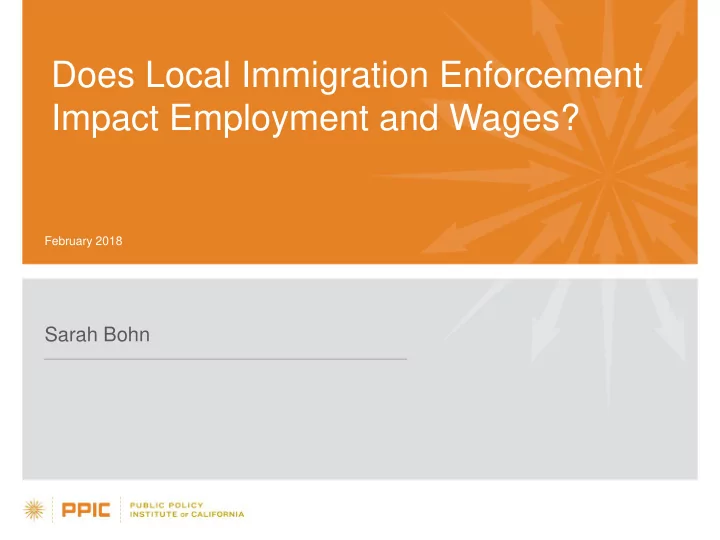

Does Local Immigration Enforcement Impact Employment and Wages? February 2018 Sarah Bohn
“There’s no denying this generation long surge in low skilled immigration has hurt blue collar wages …If we can reduce the number of low skill immigrants coming into the country, that will reduce the pool of labor, put upward pressure on wages and bring more Americans back into the labor force ” -Rep Tom Cotton, R-Arkansas, 2017
Unauthorized immigrant population in the U.S. declining after 2007 peak Number of unauthorized immigrants (millions) Source: Passel and Cohn (2017), Pew Hispanic Center http://www.pewresearch.org/fact-tank/2017/04/25/as- 3 mexican-share-declined-u-s-unauthorized-immigrant-population-fell-in-2015-below-recession-level/
Source: Estimates pertain to 2008; Hill and Johnson (2011), PPIC http://www.ppic.org/publication/unauthorized-immigrants-in-california-estimates-for-counties/
Unauthorized immigrants comprise a disproportionate share of select industries Overall labor force Overall labor force Manufacturing Manufacturing Apparel manufacturing Administrative Services Administrative Services Landscaping, Building maintenance Accommodation & Food Services Accommodation & Food Services Private household employment Construction Construction Agriculture Agriculture Crop production 0 0 5 5 10 10 15 15 20 20 25 25 Share of Employment by Unauthorized Immigrants (%) Share of Employment by Unauthorized Immigrants (%) Source: Passel et al (2016), Pew Research Center
This study (with Rob Santillano) How does local immigration enforcement impact employment and wages at the local level? Local enforcement policy we study: 287(g) agreements Economic impacts measured in Quarterly Census of Employment and Wages (QCEW) data, 2005-2009 Empirical strategy: D-in-D w/controls for local shocks
287(g) local immigration enforcement in context 287(g): law enforcement agreements with ICE – Jail: enforced in jails – Task Force: enforced in public Local and state laws on employment, housing, law enforcement (wide mix, hard to classify) Other federal laws/programs implemented locally – E-Verify – Secure Communities: in jails – Criminal Aliens Program: in jails
Local 287(g) jurisdictions spread out across the U.S. Policy implemented (treated) Subsequent Policy (sometimes treated) No Policy (comparison)
Some impacts observed across communities Anecdotal evidence on 287(g) is mixed – Demographic changes and economic “damage” (CAP, 2011) – But also immigrants return when policy not enforced Limited research – Fewer students following 287(g) (O’Neil 2011) – Some immigrants left some areas (Capps et al 2011) – Small negative effects in some industries (Pham and Van 2010) – Do not control for confounding factors 9
Hypothetical economic impacts of 287(g) Intended impact of 287(g): deter or remove immigrants Economic theory suggests – Lower overall employment likely – Lower production or lower demand for goods & services – Less work in the shadows? increase employment (that is officially reported) Depends on the extent to which U.S. workers fill jobs vacated by immigrants 10
Data & Analysis Quarterly Census of Employment and Wages (QCEW) – County-level, 2-digit industry – Based on official UI reporting Policy database – 287(g) agreement dates and agencies – Local and state immigration laws 2005-2009 – Kevin O’Neil – National Conference of State Legislatures Compare counties with 287(g) agreements to neighbors with similar economies
Does overall employment change in 287(g) jurisdictions? All industries 0.1 Manufacturing 4.2* Construction -2 Accommodation and Food Services -2.1 Administrative Services -10* -12 -10 -8 -6 -4 -2 0 2 4 6 Percent Change in Employment *statistically significant at the 5% level or better 12
Do wages change in 287(g) jurisdictions? All industries 0 Manufacturing -0.1 Construction -2.3* Accommodation and Food Services -0.9 Administrative Services 1.4* -12 -10 -8 -6 -4 -2 0 2 4 6 Percent Change in Wages *statistically significant at the 5% level or better 13
In summary Little evidence of county-wide economic effects of 287(g) But key immigrant-heavy industries experience declines in labor market activity Shifts in informal work might be even more dramatic 14
Labor market consequences of The Legal Arizona Workers Act (LAWA) Mandated E-Verify as of January 1, 2008 Imposed employer sanctions What happened to the unauthorized population? – Decreased by 17% – Fewer employed (11% drop) – Huge increase in self-employment (double) Benefits to US-born workers or firms? – No Source: Bohn, Lofstrom, and Raphael (2011, 2014 and 2015)
Takeaways Interior enforcement laws can be effective…. …but have economic consequences beyond their intent Evidence to-date finds adverse consequences on employment and economic activity and no benefit to U.S. workers 17
Notes on the use of these slides These slides were created to accompany a presentation. They do not include full documentation of sources, data samples, methods, and interpretations. To avoid misinterpretations, please contact: Sarah Bohn (bohn@ppic.org; 415-291-4413) Thank you for your interest in this work. 18
Supplementary Slides 19
The undocumented population in California appears to be declining Source: PPIC Just the Facts “Undocumented Immigrants in California” by Joe Hayes and Laura Hill, March 20 2017
State Legislation on Employment of Unauthorized Immigrants No legislation State laws regarding employment eligibility E-Verify legislation pending E-Verify mandated for state employees/contractors E-Verify mandated for all employers Source: Bohn, Lofstrom, and Raphael (2011), data for 2005-2010
Recommend
More recommend